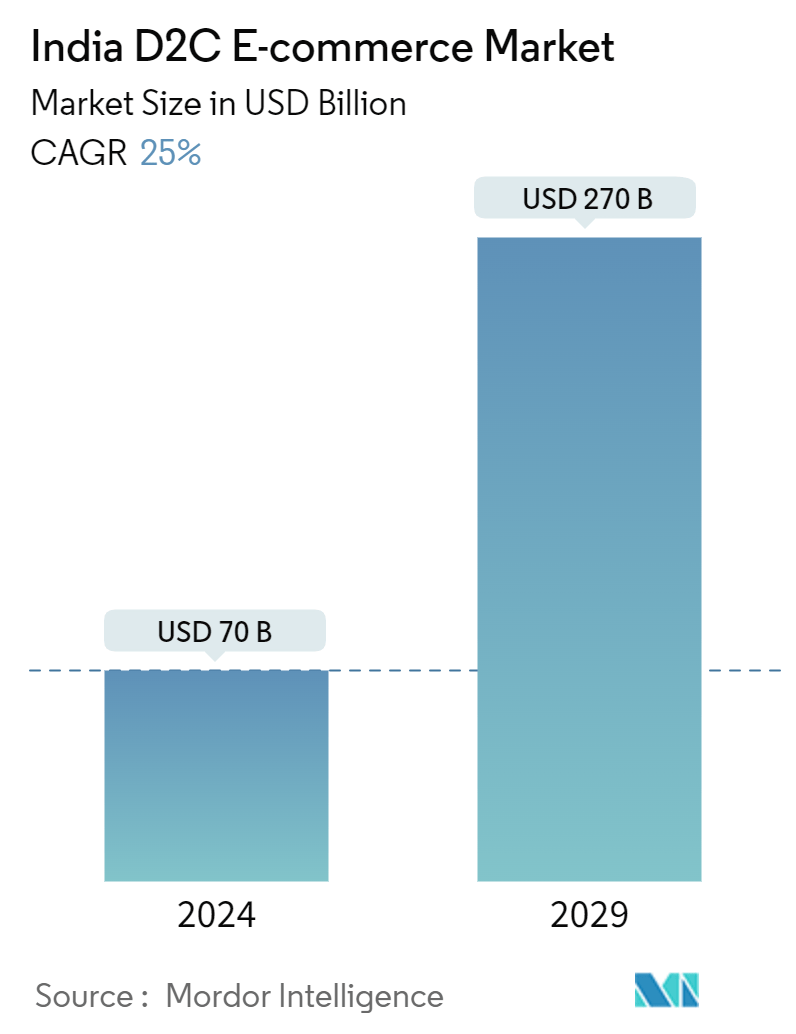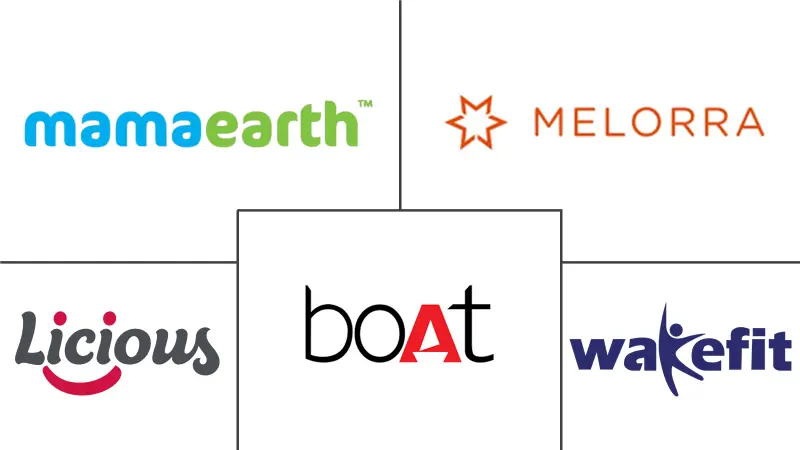Market Size of India D2C E-commerce Industry

| Study Period | 2019 - 2029 |
| Base Year For Estimation | 2023 |
| Market Size (2024) | USD 70 Billion |
| Market Size (2029) | USD 270 Billion |
| CAGR (2024 - 2029) | 25.00 % |
| Market Concentration | Low |
Major Players
*Disclaimer: Major Players sorted in no particular order |
India D2C E-commerce Market Analysis
The India D2C E-commerce Market size is estimated at USD 70 billion in 2024, and is expected to reach USD 270 billion by 2029, growing at a CAGR of 25% during the forecast period (2024-2029).
- Direct-to-consumer (D2C) e-commerce is a business model where companies sell their products directly to buyers, bypassing traditional retail stores. This direct approach fosters direct communication between the buyer and the brand, fostering brand loyalty, understanding customer preferences, and driving repeat purchases. D2C e-commerce is pivotal, allowing manufacturers to sell directly to consumers via their online storefronts (referred to as business-to-consumer or B2C).
- Embracing a D2C e-commerce strategy empowers manufacturers with end-to-end control, spanning from packaging to marketing. With robust consumer spending and a surging e-commerce penetration rate, the Indian D2C market is poised for growth during the forecast period. Moreover, D2C platforms grant consumers the flexibility to purchase products of their preference, amplifying the allure of online shopping. As the appetite for digital e-commerce products grows, it further fuels the Indian market's momentum.
- The direct-to-consumer (D2C) model offers brands a wider range of choices for product testing. Brands have the ability to conduct pre-sales or introduce limited-time offers for specific products, beta test newly developed products, and decide on which products to manufacture, in what quantities, and where. Additionally, through the D2C model, brands can strategize their packaging, including sustainable packaging, to lower expenses, meet customer demands, and enhance their overall customer experience.
- In recent years, India's rising direct-to-consumer (D2C) business model has caused significant upheaval and change within the e-commerce industry. This expansion can be credited to the surge in e-commerce and internet usage, improved last-mile logistics, and a rise in consumer technology awareness, particularly among the growing millennial and Gen Z consumer base. As a result, consumers in the area are progressively turning to digital platforms for their shopping requirements, and D2C brands are capitalizing on this trend by providing inventive products and tailored services.
- The pandemic accelerated the merging of offline and online shopping in India. Brands are now incorporating online sales channels to guarantee a smooth shopping experience for customers. Additionally, numerous D2C brands are implementing technology-driven solutions to optimize supply chain and warehouse management processes. According to IBEF, the overall e-commerce market is projected to reach USD 350 billion by 2030, with major segments such as D2C expected to reach USD 60 billion by FY 2027.
- As fashion preferences continue to change, direct-to-consumer (D2C) brands are expected to have a significant impact on driving the growth of the fashion industry in the country. According to the e-commerce platform Myntra, digital-first companies are gaining more traction in India, with the fashion D2C market projected to reach USD 43.2 billion by 2025. It also highlights that Indian D2C brands have the opportunity to target a market with the third-largest digital purchasing base globally. Furthermore, India's consumer base is anticipated to reach 400-450 million by 2027.
- The personal care industry in India is advancing in tandem with increasing awareness and health consciousness among consumers. Furthermore, companies in the beauty and personal care industry are spearheading the consumer market by introducing new products, ingredients, and messaging, as well as utilizing technology and the internet to effectively reach a wide audience. The widespread availability of affordable smartphones and growing access to high-speed internet services has digitally connected millions of Indians, enabling them to purchase personal care products.
- Utilizing the D2C model allows a new company to present its product directly to consumers and make sales without intermediaries. This method eradicates the inefficiencies of the traditional supply chain and enables brands to establish a direct connection with their customers. Notable D2C brands in the market under examination include Mamaearth, a startup that has reached a valuation exceeding USD 1 billion. This startup has effectively conducted direct sales to its clientele, fostering trust in a short period of time.
- Nevertheless, D2C online platforms, particularly startups, encounter difficulties related to supply chain visibility as customers expect complete transparency in their orders. This necessitates the implementation of an effective delivery tracking system for any D2C brand.
India D2C E-commerce Industry Segmentation
The market study includes the evolving customer journey across various online D2C models, key drivers influencing growth, challenges, and major technologies that will drive innovation in the Indian D2C e-commerce market. The market tracks the revenues accrued by companies selling directly to the customers through their own website or app without the intervention of any other third party.
The Indian D2C e-commerce market is segmented by end-user vertical. By end-user vertical, the market is segmented by apparel and footwear, grocery and gourmet, personal care, home décor and household supplies, healthcare, and jewelry. The market sizes and forecasts are provided in terms of value (USD) for all the above segments.
| By End-User Vertical | |
| Apparel and Footwear | |
| Grocery and Gourmet | |
| Personal Care | |
| Home Decor and Household Supplies | |
| Healthcare | |
| Jewelry |
India D2C E-commerce Market Size Summary
The India Direct-to-Consumer (D2C) e-commerce market is experiencing rapid growth, driven by the shift towards digital platforms accelerated by the Covid-19 pandemic. This model allows companies to sell directly to consumers, bypassing traditional retail intermediaries, which fosters direct communication and strengthens brand loyalty. The increasing consumer spending and e-commerce penetration in India are key factors propelling this market. D2C e-commerce offers significant advantages, such as complete control over branding and marketing, which has proven effective for companies like Mamaearth and the Good Glamm Group. The model also enables startups to eliminate traditional supply chain inefficiencies, directly connecting with consumers and tapping into underserved market segments, particularly in fashion and personal care.
The D2C e-commerce landscape in India is characterized by a surge in startups and established brands leveraging digital platforms to reach a broader audience. The fashion industry, in particular, has seen a significant transformation, with brands like Zivame achieving remarkable growth. The market is also witnessing increased smartphone penetration and the convenience of online shopping, further boosting D2C sales. Government initiatives to enhance rural broadband access under the Digital India campaign are expected to further accelerate market growth. Strategic acquisitions and partnerships are common as companies seek to expand their digital footprint and product offerings. Key players in the market include Mamaearth, BoAt, and Licious, who are actively investing in technology and innovation to maintain a competitive edge.
India D2C E-commerce Market Size - Table of Contents
-
1. MARKET DYNAMICS
-
1.1 Market Drivers
-
1.1.1 Higher Profit Margins by Cutting Down Intermediaries Have Encouraged Several Companies to Enter the Market
-
1.1.2 Enhanced Brand Engagement with Customers Has Led to Higher Retention
-
-
1.2 Market Challenges
-
1.2.1 Higher Customer Acquisition Costs
-
-
-
2. MARKET SEGMENTATION
-
2.1 By End-User Vertical
-
2.1.1 Apparel and Footwear
-
2.1.2 Grocery and Gourmet
-
2.1.3 Personal Care
-
2.1.4 Home Decor and Household Supplies
-
2.1.5 Healthcare
-
2.1.6 Jewelry
-
-
India D2C E-commerce Market Size FAQs
How big is the India D2C E-commerce Market?
The India D2C E-commerce Market size is expected to reach USD 70 billion in 2024 and grow at a CAGR of 25% to reach USD 270 billion by 2029.
What is the current India D2C E-commerce Market size?
In 2024, the India D2C E-commerce Market size is expected to reach USD 70 billion.

